Sir John Monash, Personal Files Book 14, 1 December 1916 - 10 February 1917, Part 1
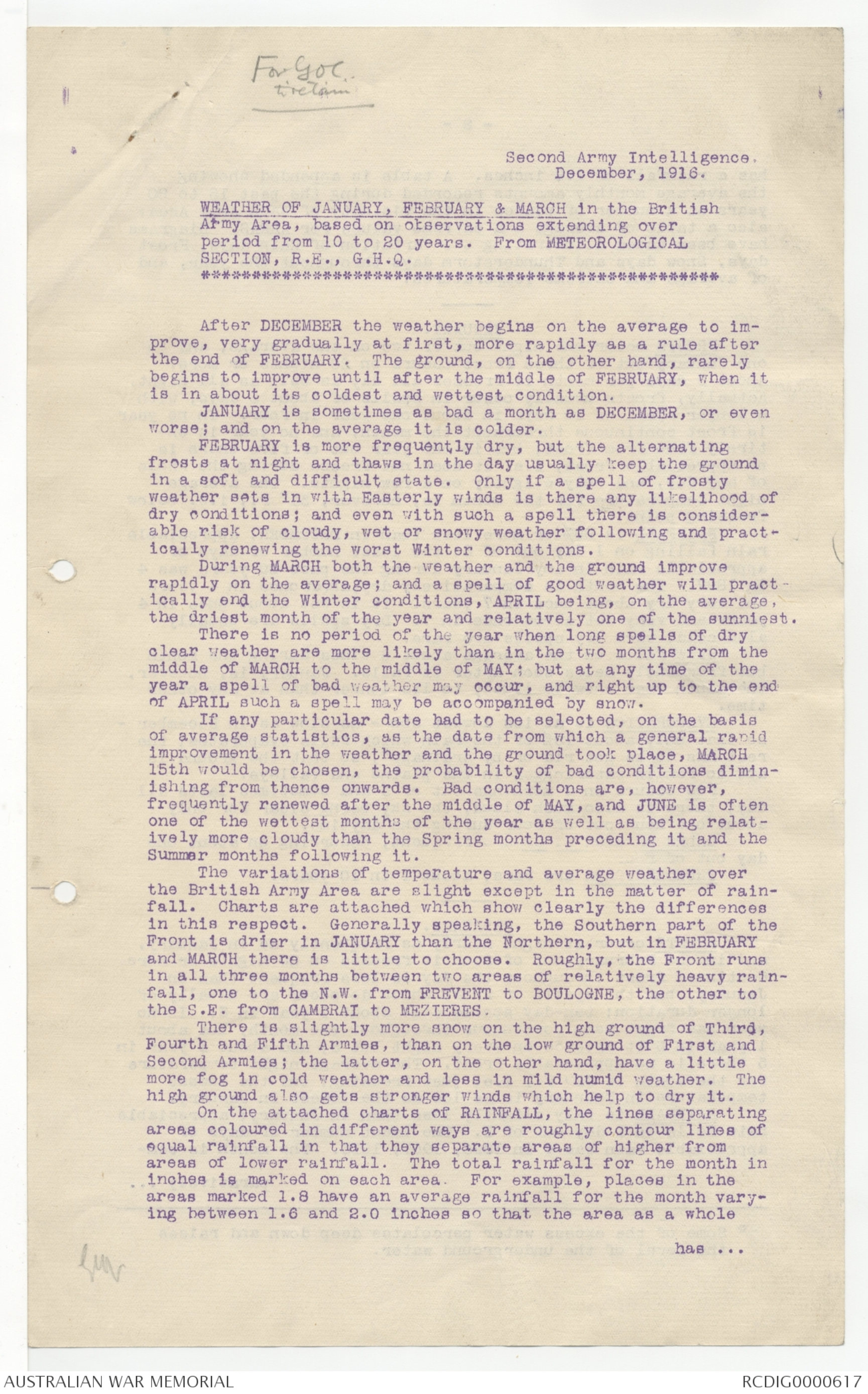
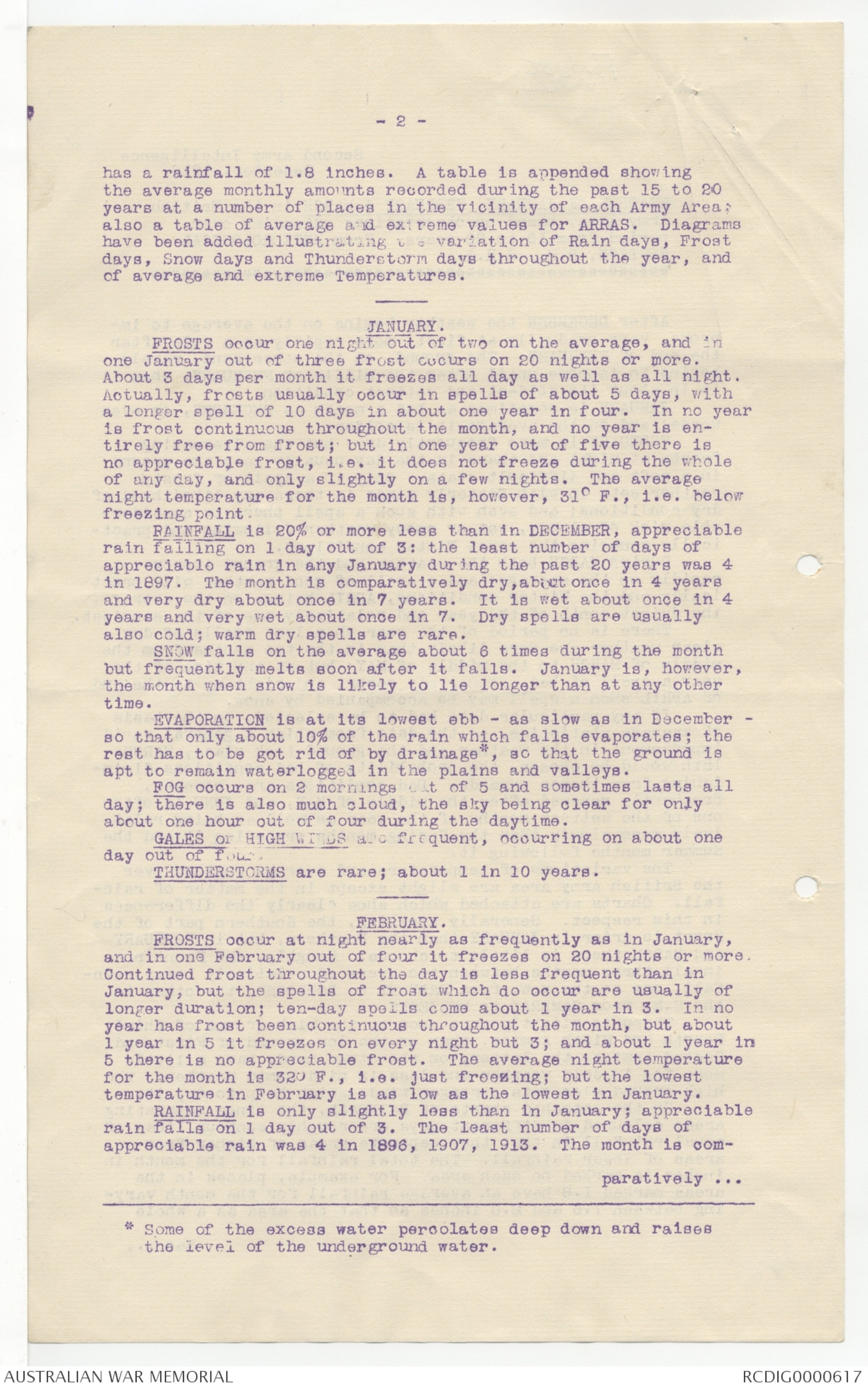
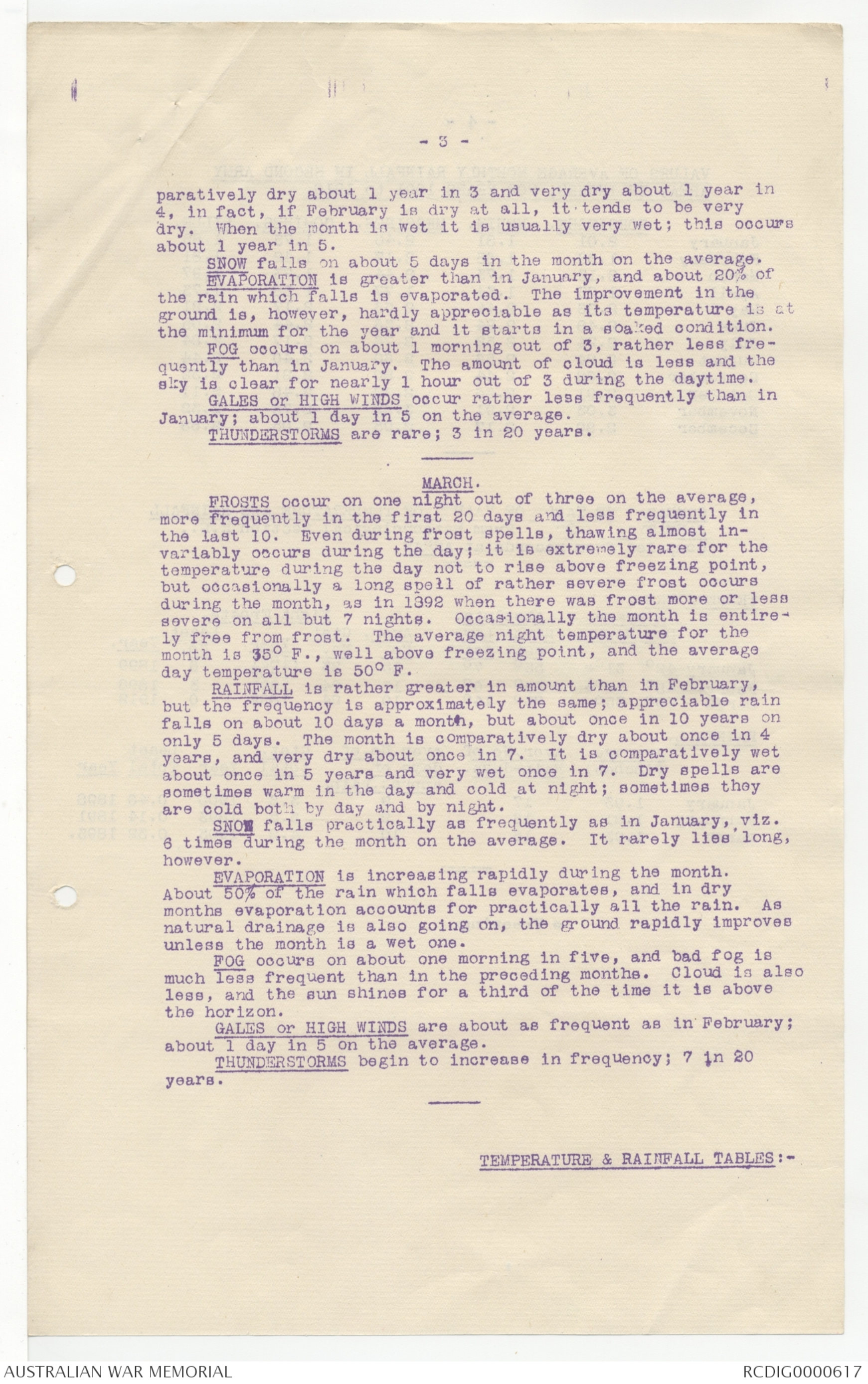
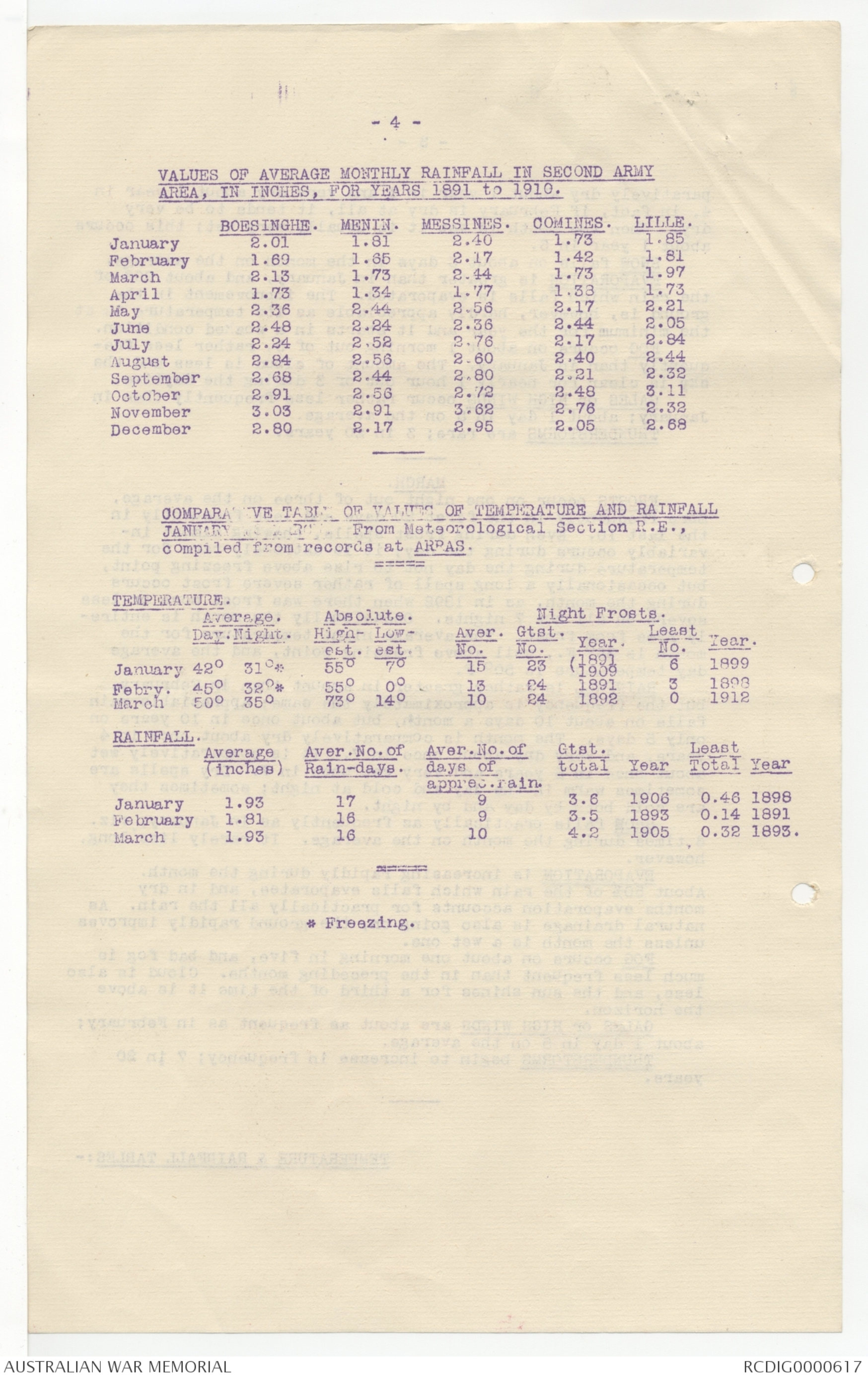
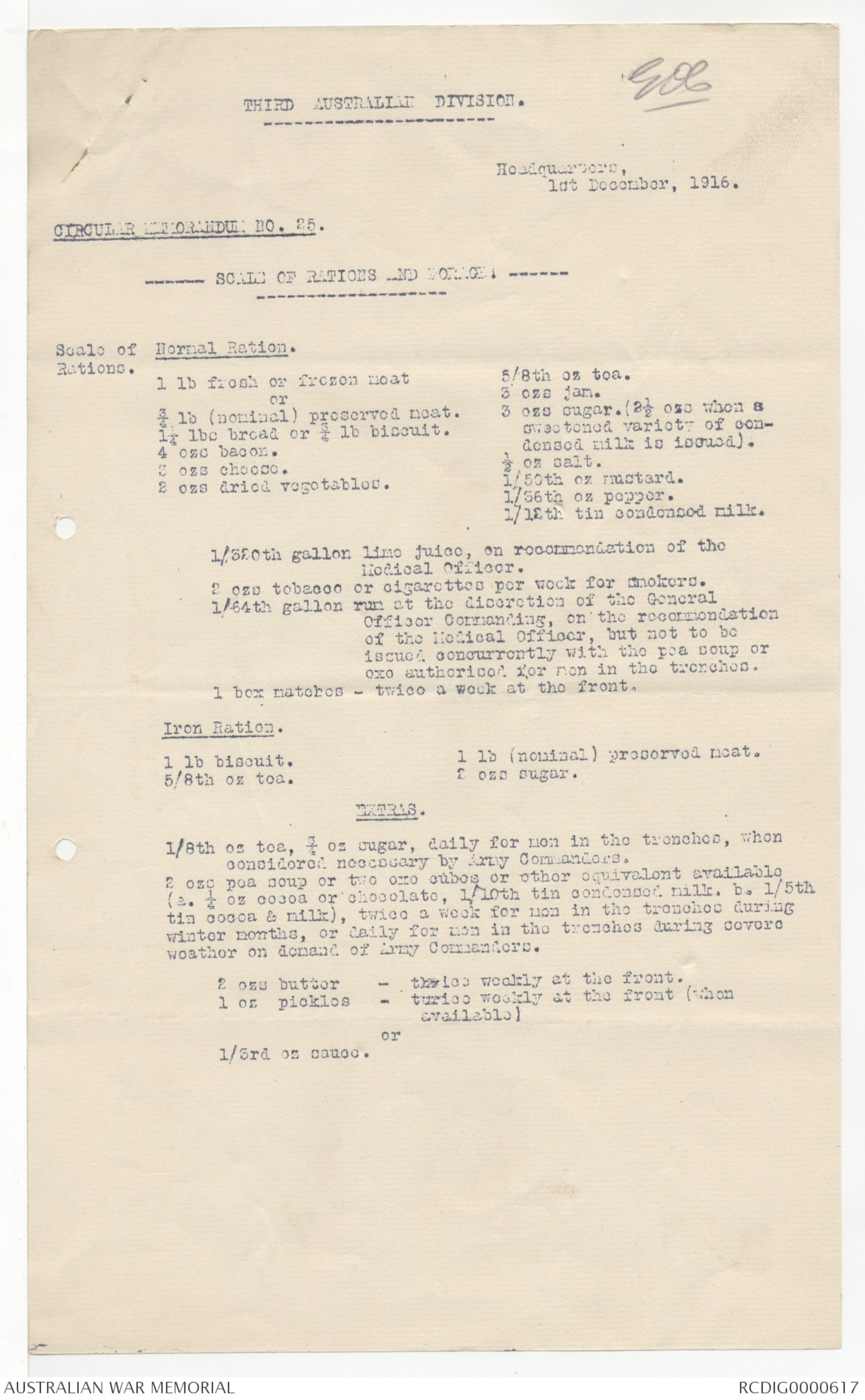
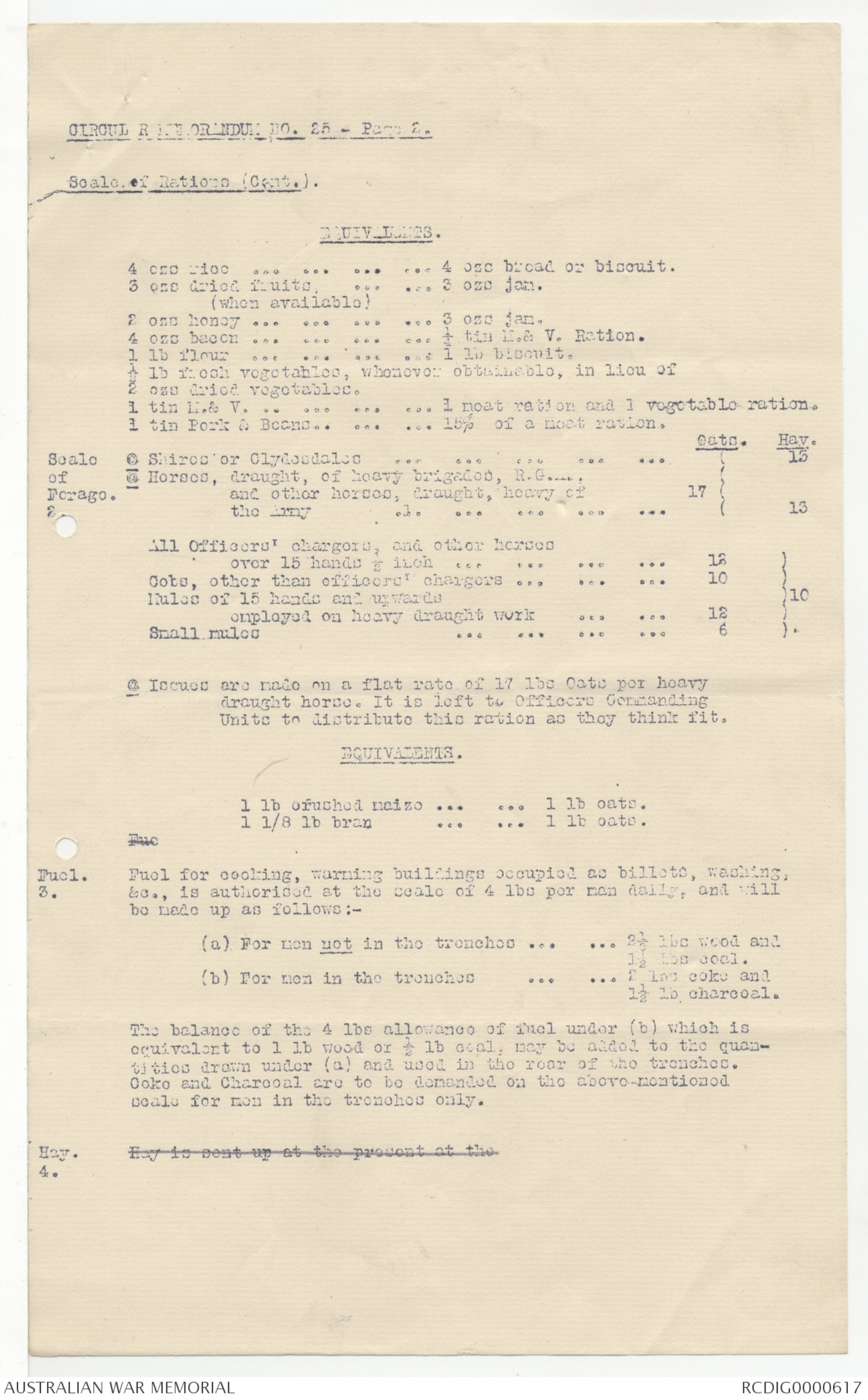
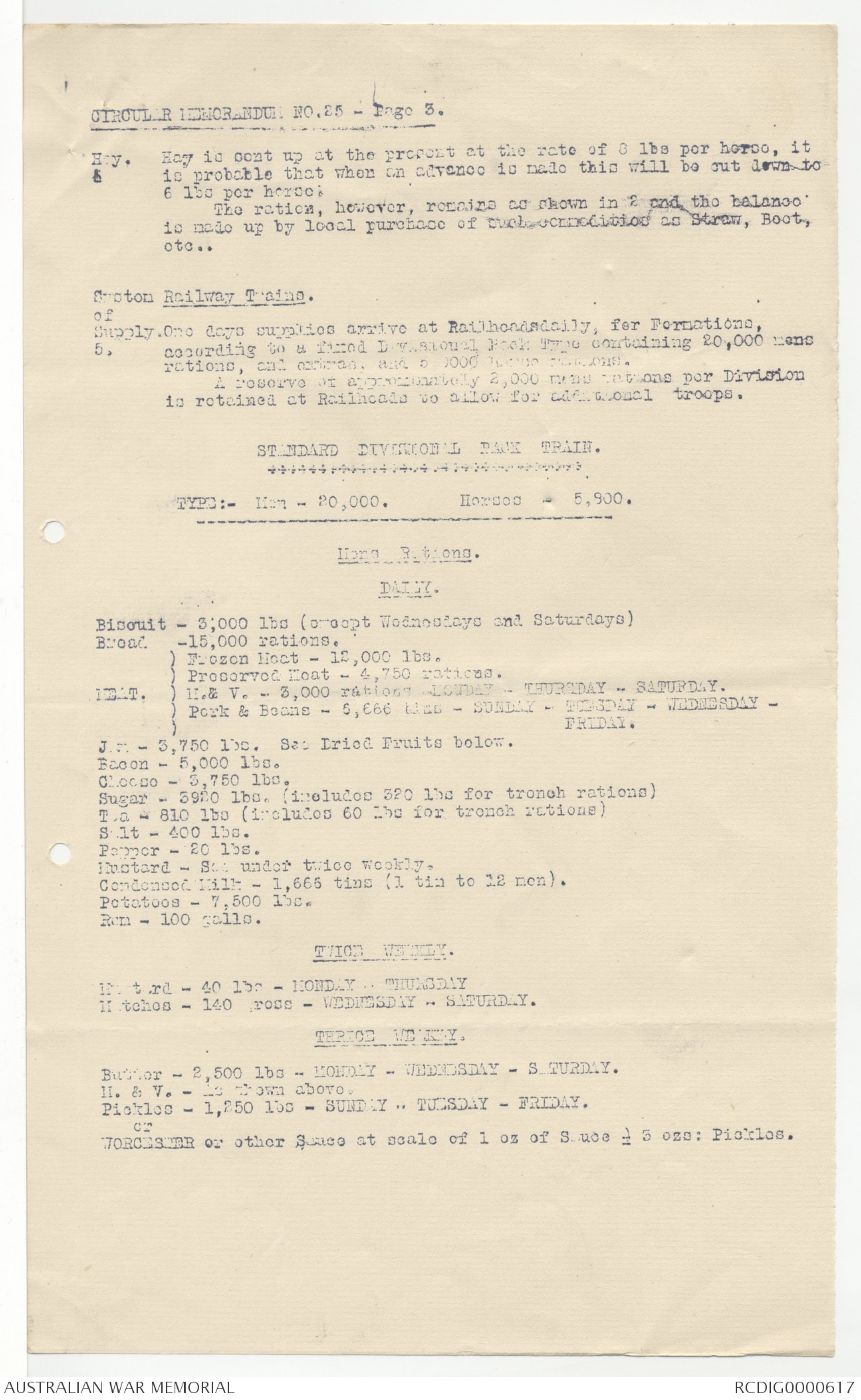
[*For G O.C.
to retain*]
Second Army Intelligence.
December, 1916.
WEATHER OF JANUARY, FEBRUARY & MARCH in the British
Army Area, based on observations extending over
period from 10 to 20 years. From METEOROLOGICAL
SECTION, R.E., G.H.Q.
After DECEMBER the weather begins on the average to improve,
very gradually at first, more rapidly as a rule after
the end of FEBRUARY. The ground, on the other hand, rarely
begins to improve until after the middle of FEBRUARY, when it
is in about its coldest and wettest condition.
JANUARY is sometimes as bad a month as DECEMBER, or even
worse ; and on the average it is colder.
FEBRUARY is more frequently dry, but the alternating
frosts at night and thaws in the day usually keep the ground
in a soft and difficult state. Only if a spell of frosty
weather sets in with Easterly winds is there any likelihood of
dry conditions ; and even with such a spell there is considerable
risk of cloudy, wet or snowy weather following and practically
renewing the worst Winter conditions.
During MARCH both the weather and the ground improve
rapidly on the average ; and a spell of good weather will practically
end the Winter conditions, APRIL being, on the average,
the driest month of the year and relatively one of the sunniest.
There is no period of the year when long spells of dry
clear weather are more likely than in the two months from the
middle of MARCH to the middle of MAY ; but at any time of the
year a spell of bad weather may occur, and right up to the end
of APRIL such a spell may be accompanied by snow.
If any particular date had to be selected, on the basis
of average statistics, as the date from which a general rapid
improvement in the weather and the ground took place, MARCH
15th would be chosen, the probability of bad conditions diminishing
from thence onwards. Bad conditions are, however,
frequently renewed after the middle of MAY, and JUNE is often
one of the wettest months of the year as well as being relatively
more cloudy than the Spring months preceding it and the
Summer months following it.
The variations of temperature and average weather over
the British Army Area are slight except in the matter of rainfall.
Charts are attached which show clearly the differences
in this respect. Generally speaking, the Southern part of the
Front is drier in JANUARY than the Northern, but in FEBRUARY
and MARCH there is little to choose. Roughly, the Front runs
in all three months between two areas of relatively heavy rainfall,
one to the N.W. from FREVENT to BOULOGNE, the other to
the S.E. from CAMBRAI to MEZIERES.
There is slightly more snow on the high ground of Third,
Fourth and Fifth Armies, than on the low ground of First and
Second Armies ; the latter, on the other hand, have a little
more fog in cold weather and less in mild humid weather. The
high ground also gets stronger winds which help to dry it.
On the attached charts of RAINFALL, the lines separating
areas coloured in different ways are roughly contour lines of
equal rainfall in that they separate areas of higher from
areas of lower rainfall. The total rainfall for the month in
inches is marked on each area. For example, places in the
areas marked 1.8 have an average rainfall for the month varying
between 1.6 and 2.0 inches so that the area as a whole
has . . .
[*[[?]]*]
- 2 -
has a rainfall of 1.8 inches. A table is appended showing
the average monthly amounts recorded during the past 15 to 20
years at a number of places in the vicinity of each Army Area;
also a table of average and extreme values for ARRAS. Diagrams
have been added illustrating the variation of Rain days, Frost
days, Snow days and Thunderstorm days throughout the year, and
of average and extreme Temperatures.
JANUARY.
FROSTS occur one night out of two on the average, and in
one January out of three frost occurs on 20 nights or more.
About 3 days per month it freezes all day as well as all night.
Actually, frosts usually occur in spells of about 5 days, with
a longer spell of 10 days in about one year in four. In no year
is frost continuous throughout the month, and no year is entirely
free from frost; but in one year out of five there is
no appreciable frost, i.e. it does not freeze during the whole
of any day, and only slightly on a few nights. The average
night temperature for the month is, however, 31° F., i.e. below
freezing point.
RAINFALL is 20% or more less than in DECEMBER, appreciable
rain falling on 1 day out of 3: the least number of days of
appreciable rain in any January during the past 20 years was 4
in 1897. The month is comparatively dry, about once in 4 years
and very dry about once in 7 years. It is wet about once in 4
years and very wet once in 7. Dry spells are usually
also cold; warm dry spells are rare.
SNOW falls on the average about 6 times during the month
but frequently melts soon after it falls. January is, however,
the month when snow is likely to lie longer than at any other
time.
EVAPORATION is at its lowest ebb - as slow as in December -
so that only about 10% of the rain which falls evaporates; the
rest has to be got rid of by drainage*, so that the ground is
apt to remain waterlogged in the plains and valleys.
FOG occurs on 2 mornings out of 5 and sometimes lasts all
day; there is also much cloud, the sky being clear for only
about one hour out of four during the daytime.
GALES or HIGH WINDS are frequent, occurring on about one
day out of four.
THUNDERSTORMS are rare; about 1 in 10 years.
FEBRUARY.
FROSTS occur at night nearly as frequently as in January,
and in one February out of four it freezes on 20 nights or more.
Continued frost throughout the day is less frequent than in
January, but the spells of frost which do occur are usually of
longer duration; ten-day spells come about 1 year in 3. In no
year has frost been continuous throughout the month, but about
1 year in 5 it freezes on every night but 3; and about 1 year in
5 there is no appreciable frost. The average night temperature
for the month is 32° F., i.e. just freezing; but the lowest
temperature in February is as low as the lowest in January.
RAINFALL is only slightly less than in January; appreciable
rain falls on 1 day out of 3. The least number of days of
appreciable rain was 4 in 1896, 1907, 1913. The month is comparatively ...
* Some of the excess water percolates deep down and raises
the level of underground water.
- 3 -
paratively dry about 1 year in 3 and very dry about 1 year in
4, in fact, if February is dry at all, it tends to be very
dry. When the month is wet it is usually very wet; this occurs
about 1 year in 5.
SNOW falls on about 5 days in the month on the average.
EVAPORATION is greater than in January, and about 20% of
the rain which falls is evaporated. The improvement in the
ground is, however, hardly appreciable as its temperature is at
the minimum for the year and it starts in a soaked condition.
FOG occurs on about 1 morning out of 3, rather less frequently
than in January. The amount of cloud is less and the
sky is clear for nearly 1 hour out of 3 during the daytime.
GALES or HIGH WINDS occur rather less frequently than in
January; about 1 day in 5 on the average.
THUNDERSTORMS are rare; 3 in 20 years.
MARCH.
FROSTS occur on one night out of three on the average,
more frequently in the first 20 days and less frequently in
the last 10. Even during frost spells, thawing almost invariably
occurs during the day; it is extremely rare for the
temperature during the day not to rise above freezing point,
but occasionally a long spell of rather severe frost occurs
during the month, as in 1892 when there was frost more or less
severe on all but 7 nights. Occasionally the month is entirely
free from frost. The average night temperature for the
month is 35° F., well above freezing point, and the average
day temperature is 50° F.
RAINFALL is rather greater in amount than in February,
but the frequency is approximately the same; appreciable rain
falls on about 10 days a month, but about once in 10 years on
only 5 days. The month is comparatively dry about once in 4
years, and very dry about once in 7. It is comparatively wet
about once in 5 years and very wet once in 7. Dry spells are
sometimes warm in the day and cold at night; sometimes they
are cold both by day and by night.
SNOW falls practically as frequently as in January, viz.
6 times during the month on the average. It rarely lies long,
however.
EVAPORATION is increasing rapidly during the month.
About 50% of the rain which falls evaporates, and in dry
months evaporation accounts for practically all the rain. As
natural drainage is also going on, the ground rapidly improves
unless the month is a wet one.
FOG occurs on about one morning in five, and bad fog is
much less frequent than in the preceding months. Cloud is also
less, and the sun shines for a third of the time it is above
the horizon.
GALES or HIGH WINDS are about as frequent as in February;
about 1 day in 5 on the average.
THUNDERSTORMS begin to increase in frequency; 7 in 20
years.
TEMPERATURE & RAINFALL TABLES:-
- 4 -
VALUES OF AVERAGE MONTHLY RAINFALL IN SECOND ARMY
AREA, IN INCHES, FOR YEARS 1891 TO 1910.
BOESINGHE. MENIN. MESSINES. COMINES. LILLE.
January 2.01 1.81 2.40 1.73 1.85
February 1.69 1.65 2.17 1.42 1.81
March 2.13 1.73 2.44 1.73 1.97
April 1.73 1.34 1.77 1.38 1.73
May 2.36 2.44 2.56 2.17 2.21
June 2.48 2.24 2.36 2.44 2.05
July 2.24 2.52 2.76 2.17 2.84
August 2.84 2.56 2.60 2.40 2.44
September 2.68 2.44 2.80 2.21 2.32
October 2.91 2.56 2.72 2.48 3.11
November 3.03 2.91 3.62 2.76 2.32
December 2.80 2.17 2.95 2.05 2.68
COMPARATIVE TABLE OF VALUES OF TEMPERATURE AND RAINFALL
JANUARY to MARCH From Meteorological Section R.E.,
compiled from records at ARRAS.
| TEMPERATURE. | |||||||||
| Average. | Absolute. |
Night Frosts. |
|||||||
| Day. | Night. | Highest. | Lowest. | Aver. No. |
Gtst. No. |
Year
|
Least No. |
Year.
|
|
| January | 42° | 31°* | 55° | 7° | 15 | 23 |
(1891 (1909 |
6 | 1899 |
| Febry. | 45° | 32°* | 55° | 0° | 13 | 24 | 1891 | 3 | 1898 |
| March | 50° | 35° | 73° | 14° | 10 | 24 | 1892 | 0 | 1912 |
|
RAINFALL. |
|||||||
| Average (inches) |
Aver. No. of Rain-days. |
Aver. No. of days of apprec. rain |
Gtst. total |
Year |
Least Total |
Year |
|
| January | 1.93 | 17 | 9 | 3.6 | 1906 | 0.46 | 1898 |
| February | 1.81 | 16 | 9 | 3.5 | 1893 | 0.14 | 1891 |
| March | 1.93 | 16 | 10 | 4.2 | 1905 | 0.32 | 1893. |
* Freezing.
[*GOC*]
THIRD AUSTRALIAN DIVISION.
Headquarters,
1st December, 1916.
CIRCULAR MEMORANDUM no. 25
SCALE OF RATIONS AND FORAGE.
Scale of Rations.
| Normal Ration. | |
|
1 lb fresh or frozen meat or |
5/8th oz tea. |
| ¾ lb (nominal) preserved meat. | 3 ozs jam. |
| 1¼ lbs bread or ¾ lb biscuit. |
3 ozs sugar. (2½ ozs when a sweetened variety of condensed milk is issued). |
| 4 ozs bacon. | ½ oz salt |
| 3 ozs cheese. | 1/50th oz mustard. |
| 2 ozs dried vegetables. | 1/36th oz pepper. |
| 1/12th tin condensed milk. |
1/320th gallon lime juice, on recommendation of the
Medical Officer.
2 ozs tobacco or cigarettes per week for smokers.
1/64th gallon rum at the discretion of the General
Officer Commanding, on the recommendation
of the Medical Officer, but not to be
issued concurrently with the pea soup or
oxo authorised for men in the trenches.
1 box of matches - twice a week at the front.
| Iron Ration. | |
| 1 lb biscuit. | 1 lb (nominal) preserved meat. |
| 5/8th oz tea. | 2 ozs sugar. |
EXTRAS.
1/8th oz tea, ¾ oz sugar, daily for men in the trenches, when
considered necessary by Army Commanders.
2 ozs pea soup or 2 oxo cubes or other equivalent available
(a. ¼ oz coca or chocolate, 1/10th tin condensed milk. b. 1/5th
tin cocoa & milk), twice a week for men in the trenches during
winter months, or daily for men in the trenches during severe
weather on demand of Army Commanders.
2 ozs butter - twice weekly at the front.
1 oz pickles - twice weekly at the front (when
available)
or
1/3rd oz. sauce.
CIRCULAR MEMORANDUM: NO. 25 - Page 2.
Scale of Rations (Cont.)
EQUIVALENTS.
4 ozs rice ... ... ... ... 4 ozs bread or biscuit.
3 ozs dried fruits ... ... 3 ozs jam.
(when available)
2 ozs honey ... ... ... ... 3 ozs jam.
4 ozs bacon ... ... ... ... ¼ tin M.& V. Ration.
1 lb flour ... ... ... ... 1 lb biscuit.
½ lb fresh vegetables, whenever obtainable, in lieu of
2 ozs dried vegetables.
1 tin M.& V. .. ... ... ... 1 meat ration and 1 vegetable ration.
1 tin Pork & Beans.. ... ... 15% of meat ration.
Scale of Forage. 2.
| Oats. | Hay. | |
| @ Shires or Clydesdales |
( ( 17 ( |
13 |
|
@ Horses, draught, of heavy brigades, R.G. .... and other horses , draught, heavy of the army |
13
|
|
|
All Officers' chargers, and other horses over 15 hands 1/2 inch |
12 | ) ) )10 ) ) |
| Cobs, other than officers' chargers | 10 | |
|
Mules of 15 hands and upwards employed on heavy draught work |
12 | |
| Small mules | 6 |
@ Issues are made on a flat rate of 17 lbs Oats per heavy
draught horse. It is left to Officers Commanding
Units to distribute this ration as they think fit.
EQUIVALENTS.
1 lb crushed maize ... ... 1 lb oats.
1 1/8 lb bran ... ... 1 lb oats.
Fue
Fuel. 3.
Fuel for cooking, warming buildings occupied as billets, washing,
&c., is authorised at the scale of 4 lbs per man daily, and will
be made up as follows:-
(a) For men not in the trenches ... ... 2½ lbs wood and
1½ lbs coal.
(b) For men in the trenches ... ... 2 lbs coke and
1½ lbs charcoal.
The balance of the 4 lbs allowances of fuel under (b) which is
equivalent to 1 lb wood or ½ lb coal, may be added to the quantities
drawn under (a) and used in the rear of the trenches.
Coke and Charcoal are to be demanded on the above-mentioned
scale for men in the trenches only.
Hay. 4.
Hay is sent up at the present at the
CIRCULAR MEMORANDUM NO. 25 - Page 3.
Hay. 4.
Hay is sent up at the present at the rate of 8 lbs per horse, it
is probable that when an advance is made this will be cut down to
6 lbs per horse.
The ration, however, remains as shown in 2 and the balance
is made up by local purchase of such commodities as Straw, Beet,
etc. .
System of Supply 5.
Railway Trains.
One days supplies arrive at Railheads daily, for Formations,
according to a fixed Divisional Pack Type containing 20,000 mens
rations, and extras, and 5,900 horse rations.
A reserve of approximately 2,000 mens rations per Division
is retained at Railheads to allow for additional troops.
STANDARD DIVISIONAL PACK TRAIN.
TYPE:- Men - 20,000. Horse - 5,900.
Mens Rations.
DAILY.
Biscuit - 3,000 lbs (except Wednesdays and Saturdays)
Bread - 15,000 rations.
MEAT. ) Frozen Meat - 12,000 lbs.
) Preserved Meat - 4,750 rations.
) M & V - 3,000 rations - MONDAY - THURSDAY - SATURDAY
) Pork & Beans - 5,666 tins - SUNDAY - TUESDAY - WEDNESDAY -
FRIDAY.
Jam - 3,750 lbs. See Dried Fruits below.
Bacon - 5,000 lbs.
Cheese - 3,750 lbs.
Sugar - 3920 lbs. (includes 320 lbs for trench rations)
Tea - 810 lbs (includes 60 lbs for trench rations)
Salt - 400 lbs.
Pepper - 20 lbs.
Mustard - See under twice weekly.
Condensed Milk - 1,666 tins (1 tin to 12 men).
Potatoes - 7,500 lbs.
Rum - 100 galls.
TWICE WEEKLY.
Mustard - 40 lbs - MONDAY - THURSDAY.
Matches - 140 gross - WEDNESDAY - SATURDAY.
THRICE WEEKLY.
Butter - 2,500 lbs - MONDAY - WEDNESDAY - SATURDAY.
M. & V. - as shown above.
Pickles - 1,250 lbs - SUNDAY - TUESDAY - FRIDAY.
or
WORCESTER or other Sauce at scale of 1 oz of sauce = 3 ozs: Pickles.
 Deb Parkinson
Deb ParkinsonThis transcription item is now locked to you for editing. To release the lock either Save your changes or Cancel.
This lock will be automatically released after 60 minutes of inactivity.